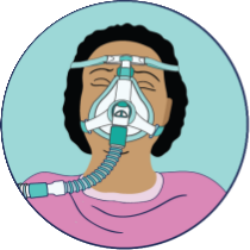Bi-level positive airway pressure (BiPAP) is a type of non-invasive ventilation treatment for patients with respiratory issues. These issues can include chronic obstructive pulmonary diseases, asthma flare-up, heart failure or sleep apnea. Being that this treatment is non-invasive, it is typically preferred to intubation. For severe cases, however, intubation may be required.
The set up for this treatment consists of a ventilation machine, tubes and a mask. The machine delivers pressurized air to the lungs through the mask, improving oxygenation. BiPAP works by adjusting the inspiratory positive airway pressure (IPAP) and the expiratory positive airway pressure (EPAP). As a patient breathes in, a higher air pressure is delivered, allowing for the lungs to open. As a patient breathes out, the air pressure is reduced, facilitating the expiration process.
BiPAP machines can be used in home and hospital settings. The frequency and length of this treatment is dependent on the severity of the respiratory condition.
General side effects of using this treatment method can include bloating, mouth dryness and skin irritation from the mask. Other complications that can arise include a leaky or overtightened mask.

